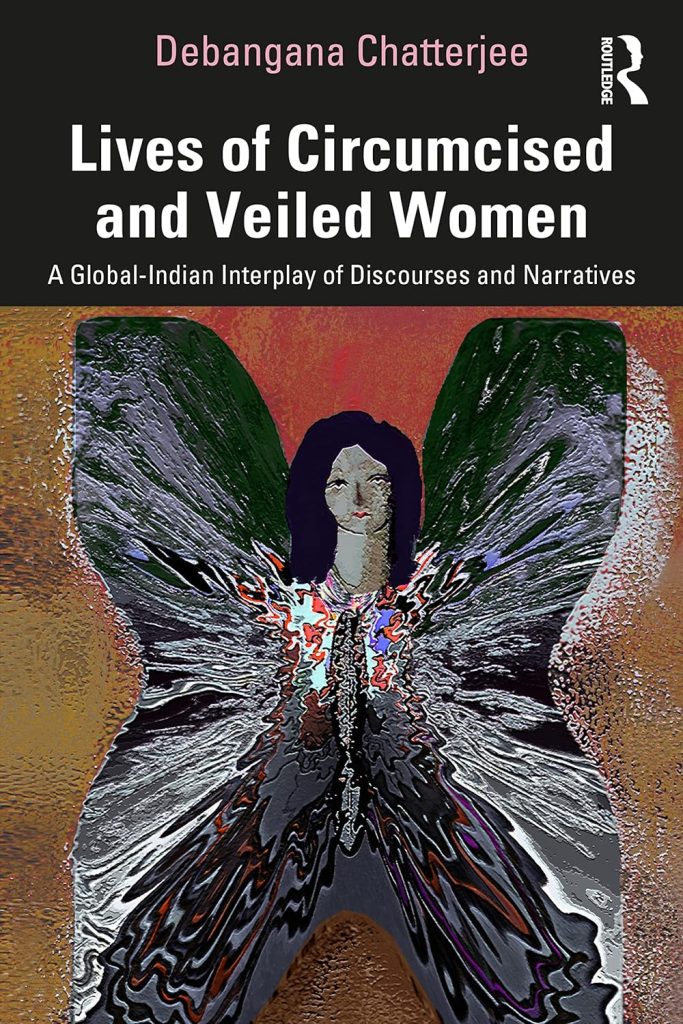Dr. Debangana Chatterjee on her New Book: Lives of Circumcised and Veiled Women: A Global-Indian Interplay of Discourses and Narratives
October 25, 2023
 We congratulate our faculty member Dr. Debangana Chatterjee on her new book Lives of Circumcised and Veiled Women: A Global-Indian Interplay of Discourses and Narratives, published by Routledge. The book unravels the politics of representation and the process of exoticising women’s bodies through the prism of external gaze and knowledge production. In this interview, we ask Debangana to share more about her book and the process of writing it.
We congratulate our faculty member Dr. Debangana Chatterjee on her new book Lives of Circumcised and Veiled Women: A Global-Indian Interplay of Discourses and Narratives, published by Routledge. The book unravels the politics of representation and the process of exoticising women’s bodies through the prism of external gaze and knowledge production. In this interview, we ask Debangana to share more about her book and the process of writing it.
1. What was your vision or inspiration behind this book?
‘Who are Women?’– given the seeming naivety of this question, though one may expect an uncomplicated answer, the answer lies in how one defines their politics. The category of ‘women’ is anything but homogeneous – albeit, the detachable entanglement of ‘women’ and ’empowerment’ minus the apostrophe is hardly able to capture the complex politics of gender. As the question transforms to ‘which’ women, my puzzle began- at an intersection of gender, culture and international politics. While conceptualising the study, I primarily envisioned bringing women’s voices to the fore and turning ‘personal’ into ‘international’— my contribution to the discipline of IR. In my book, I, therefore, seek to locate women’s agency through the mutual interplay between the global and Indian discourses.
 2. What are the primary focus areas in the book?
2. What are the primary focus areas in the book?
The book explores how the international discourses portray women’s bodies as the site of control while reflecting upon the locally shaped Indian narratives. It does so by addressing the politics of representation in and around the embodied cultural practices of female genital cutting (FGC) and veiling. The World Health Organization (WHO) defines FGC as practices that “involve partial or total removal of the external female genitalia, or other injury to the female genital organs for non-medical reasons”. However, the Indian practice is referred to as khafz, procedurally closer to female circumcision (FC). Veiling, a much more politically debatable issue given the controversies surrounding Islam, is primarily presented as the practice of covering specific body parts with particular pieces of cloth.
International discourses are, in essence, parallel cultures rooted in simultaneous belief systems, and the dominant among them creates the clout of generality. The Indian discourses, meanwhile, are context-specific, defined by nuanced narratives from women. The book captures these parallel discourses and explicates the dynamic interplay between the global and local by locating women’s agency within. At the interface of these two levels, a dilemma over the degree of acceptability of these practices remains. What’s evident is the dichotomous divide between tradition and modern, and any attempt to attribute the cultural practices to either of the binaries shrouds the nuances and leads to stereotyping.
3. What are the specific issues or challenges that the book addresses?
Although there are multiple studies on purdah, the domain of Islamic veiling in contemporary India is under-researched and unexplored. In the available literature on FC/FGC, there has been no attempt to extrapolate the mutuality of the international and Indian discourses. There is a dearth of literature on FC/FGC with a focus on Indian narratives. A version of female circumcision, known as khafz (interchangeably with khafd and khatna), is evidentially practised by the Bohra community in the Western states of India. Among the half a million Dawoodi Bohra (DB) Muslims (the predominant fraction of the Bohra community) living in India, khafz is known to be practised on girls under the age of seven. Currently, a petition at the Supreme Court of India, seeking its legal prohibition, is being heard under the Sabarimala Review Petitions. Despite the non-enumeration of the practice by the Indian government due to its numerical insignificance, the procedure remains contentious. On the other side, purdah, the umbrella term to indicate the seclusion of women in order to control their movements, stands for both Islamic and non-Islamic (ghoonghat) veiling in India. However, despite such meanings being attached to Islamic veiling, the reasons for embracing this article of clothing in contemporary India are varied and depend on the specificity of its context. While exploring the practice of Islamic veiling, the book digs deeper into the country’s minority politics and its communal overtone.
4. Who would be the primary readers of this book?
The book is definitely meant for students and researchers belonging to the academic disciplines of International Relations and Political Science, Gender Studies, Sociology, and Public Policy. Besides, the book is highly recommended for practitioners, policy advocates, and the legal community of the country who would like to deal with the nuances of FC/FGC and Islamic veiling in India as well as would be keen on understanding the international politics surrounding these.
5. Do you think there is a need for more such books today?
The answer is, yes! The reason for that is not simply my arrogant faith in its qualitative impact, but the methodological engagement and interdisciplinarity of the book. This book is a culmination of years of fieldwork resulting in lending genuine ears to what women had to share with me— something that is often missed out amidst our academic jargon. While I am not sure how successful I have been in this regard, I attempted wholeheartedly— ‘attempt’ being my only sense of triumph, as of now.
6. What was the process of working on this book?
The book is a product of a double journey— five long years of PhD and another year of manuscript making. The book highlights the fragmented narratives around FGC and Islamic veiling, showcasing the possibility of alternatives. Discourse analysis explores the multiple ways of representation through language at the international level, focusing on the socio-legal narratives from international documents and recognising the dominant narratives which are heavily influenced by the Western discourse. Undoubtedly, I utilised the luxury of time that PhD provides to spend a chunk of my time in the field— a humbling experience with limited resources that I am ever grateful for. For the practice of khafz, semi-structured personal interviews were employed (given the private nature of the practice), primarily in the urban locales of Mumbai, Surat and Ahmedabad, and scarcely in Delhi and Kolkata.
For understanding veiling, multiple focused group discussions and personal interviews of women as well as other stakeholders such as entrepreneurs and social workers were conducted in Delhi, Ahmedabad, Kolkata and Kozhikode-Malappuram. The primary task in the field has been to listen, comprehend and interpret, instead of trying to explain the phenomena. Beyond the futile quest for ‘true’ narratives, the book focuses on the ‘lives’ of women— webbed in social relationships, culture, history, and identity and lifestyle choices.
The South Asian Edition of the book is available here.

